SAAB 9-5 2005 User Guide
Manufacturer: SAAB, Model Year: 2005, Model line: 9-5, Model: SAAB 9-5 2005Pages: 276, PDF Size: 16.72 MB
Page 11 of 276
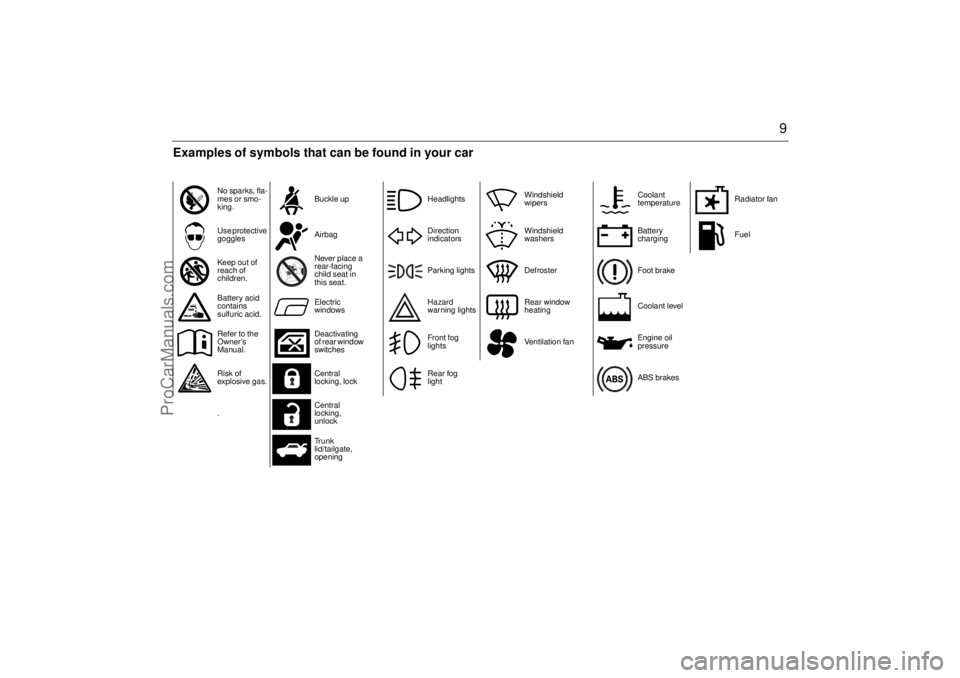
9
No sparks, fla-
mes or smo-
king.Buckle up
Use protective
gogglesAirbag
Keep out of
reach of
children.Never place a
rear-facing
child seat in
this seat.
Battery acid
contains
sulfuric acid.Electric
windows
Refer to the
Owner’s
Manual.Deactivating
of rear window
switches
Risk of
explosive gas.Central
locking, lock
.Central
locking,
unlock
Tr u n k
lid/tailgate,
opening
HeadlightsWindshield
wipers
Direction
indicatorsWindshield
washers
Parking lights Defroster
Hazard
warning lightsRear window
heating
Front fog
lightsVentilation fan
Rear fog
light
Coolant
temperatureRadiator fan
Battery
chargingFuel
Foot brake
Coolant level
Engine oil
pressure
ABS brakes
Examples of symbols that can be found in your car
ProCarManuals.com
Page 12 of 276

10(This page has been left blank)
ProCarManuals.com
Page 13 of 276
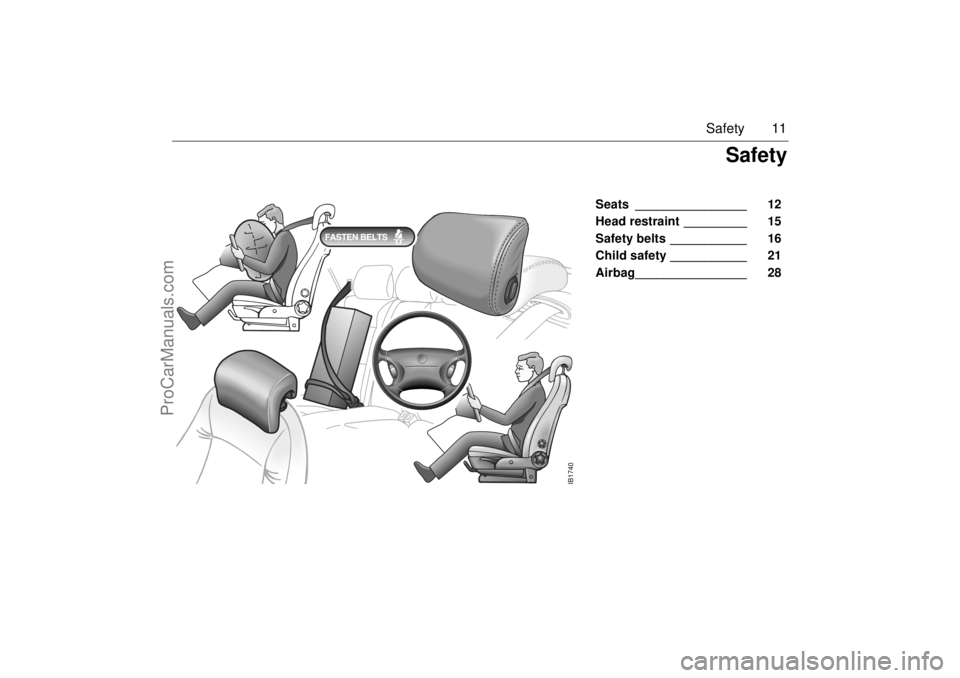
11 Safety
Seats ________________ 12
Head restraint _________ 15
Safety belts ___________ 16
Child safety ___________ 21
Airbag________________ 28
IB1740
Safety
ProCarManuals.com
Page 14 of 276
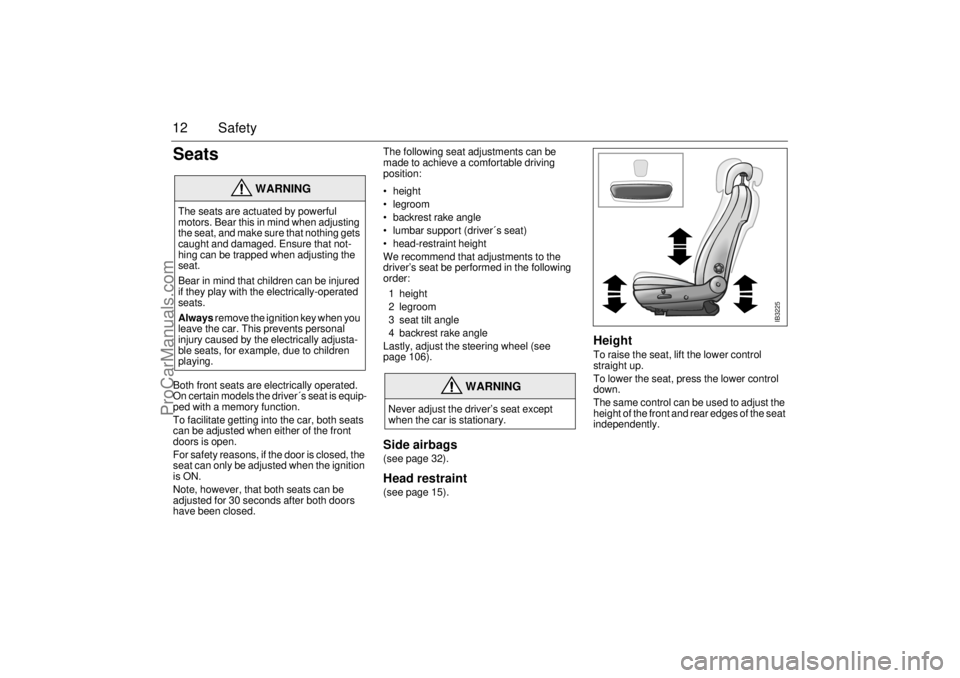
12 SafetySeats Both front seats are electrically operated.
On certain models the driver´s seat is equip-
ped with a memory function.
To facilitate getting into the car, both seats
can be adjusted when either of the front
doors is open.
For safety reasons, if the door is closed, the
seat can only be adjusted when the ignition
is ON.
Note, however, that both seats can be
adjusted for 30 seconds after both doors
have been closed. The following seat adjustments can be
made to achieve a comfortable driving
position:
height
legroom
backrest rake angle
lumbar support (driver´s seat)
head-restraint height
We recommend that adjustments to the
driver’s seat be performed in the following
order:
1height
2 legroom
3 seat tilt angle
4 backrest rake angle
Lastly, adjust the steering wheel (see
page 106).
Side airbags(see page 32).Head restraint(see page 15).
HeightTo raise the seat, lift the lower control
straight up.
To lower the seat, press the lower control
down.
The same control can be used to adjust the
height of the front and rear edges of the seat
independently.
WARNING
The seats are actuated by powerful
motors. Bear this in mind when adjusting
the seat, and make sure that nothing gets
caught and damaged. Ensure that not-
hing can be trapped when adjusting the
seat.
Bear in mind that children can be injured
if they play with the electrically-operated
seats.
Always remove the ignition key when you
leave the car. This prevents personal
injury caused by the electrically adjusta-
ble seats, for example, due to children
playing.
WARNING
Never adjust the driver’s seat except
when the car is stationary.
IB3225
ProCarManuals.com
Page 15 of 276

13 Safety
Legroom adjustmentTo adjust the legroom, push the lower con-
trol forward or back.
Backrest rake angleTo adjust the backrest, move the upper con-
trol forward or back.
Lumbar supportTurn the smaller wheel for stepless adjust-
ment of the lumbar support.
WARNING
The backrest should be upright during dri-
ving, so that the safety belt, airbag and
backrest can provide optimum protection
in the event of emergency braking or a
crash and in particular a rear-end
collision.
IB3226
IB3227
IB1161
ProCarManuals.com
Page 16 of 276

14 SafetyMemory driver’s seat(if equipped)
In certain models the driver´s seat is equip-
ped with a programmable memory function.
This function also includes the door mirrors.
Adjust the seat and door mirrors.
To save the settings, press and hold the M
button and, at the same time, press one of
the preselect buttons (1, 2 or 3). The Saab
Information Display (SID) will chime to con-
firm that the settings have been saved.To recall the programmed settings, press
and hold the appropriate preset button,
whereupon the seat and mirrors will be
adjusted automatically.
To change the settings stored in a preset
button, adjust the seat and mirrors as before
and save the new settings by pressing M
and the appropriate preset button.
To facilitate reversing, the passenger side
door mirror can be tilted down automati-
cally, e.g. to show the curb. To do this,
select reverse and press the small grey
button adjacent to the door-mirror control.
When you deselect reverse, the mirror will
automatically return to its original setting
(see page 107).
Ventilated front seats(if equipped)
Ventilated front seats, that enhance seating
comfort in hot weather, are an option on Arc
and Aero models (certain markets).
Ventilated seats are equipped with two fans
that extract the moist air from between the
seat and the body.
The fans have three speeds and are OFF
when the switch is set to 0.
IB404
IB405
ProCarManuals.com
Page 17 of 276
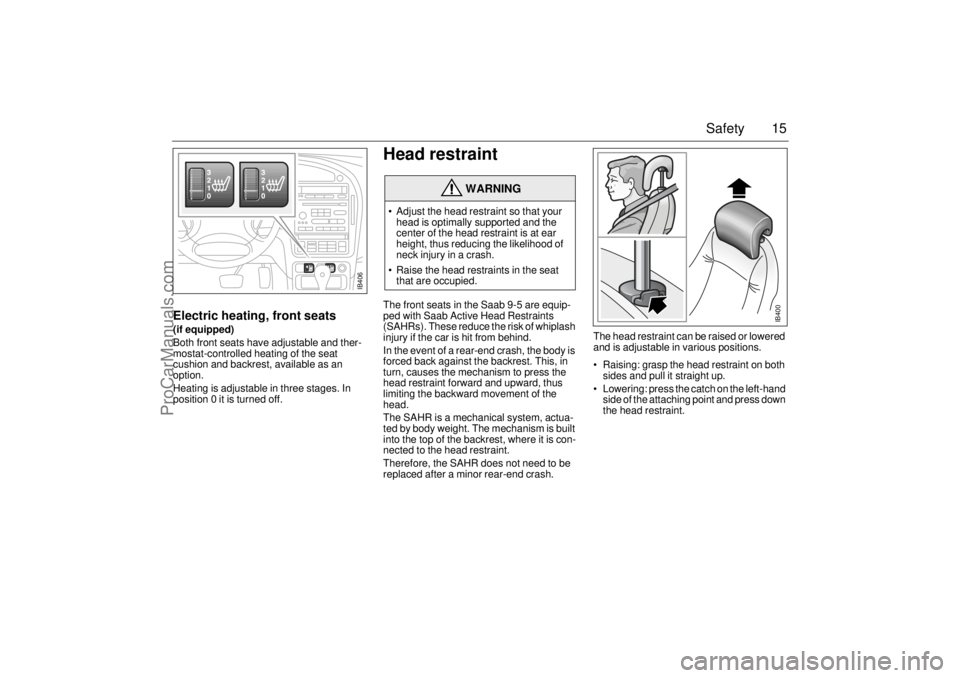
15 Safety
Electric heating, front seats(if equipped)
Both front seats have adjustable and ther-
mostat-controlled heating of the seat
cushion and backrest, available as an
option.
Heating is adjustable in three stages. In
position 0 it is turned off.
Head restraintThe front seats in the Saab 9-5 are equip-
ped with Saab Active Head Restraints
(SAHRs). These reduce the risk of whiplash
injury if the car is hit from behind.
In the event of a rear-end crash, the body is
forced back against the backrest. This, in
turn, causes the mechanism to press the
head restraint forward and upward, thus
limiting the backward movement of the
head.
The SAHR is a mechanical system, actua-
ted by body weight. The mechanism is built
into the top of the backrest, where it is con-
nected to the head restraint.
Therefore, the SAHR does not need to be
replaced after a minor rear-end crash.The head restraint can be raised or lowered
and is adjustable in various positions.
Raising: grasp the head restraint on both
sides and pull it straight up.
Lowering: press the catch on the left-hand
side of the attaching point and press down
the head restraint.
WARNING
Adjust the head restraint so that your
head is optimally supported and the
center of the head restraint is at ear
height, thus reducing the likelihood of
neck injury in a crash.
Raise the head restraints in the seat
that are occupied.
IB406
IB400
ProCarManuals.com
Page 18 of 276
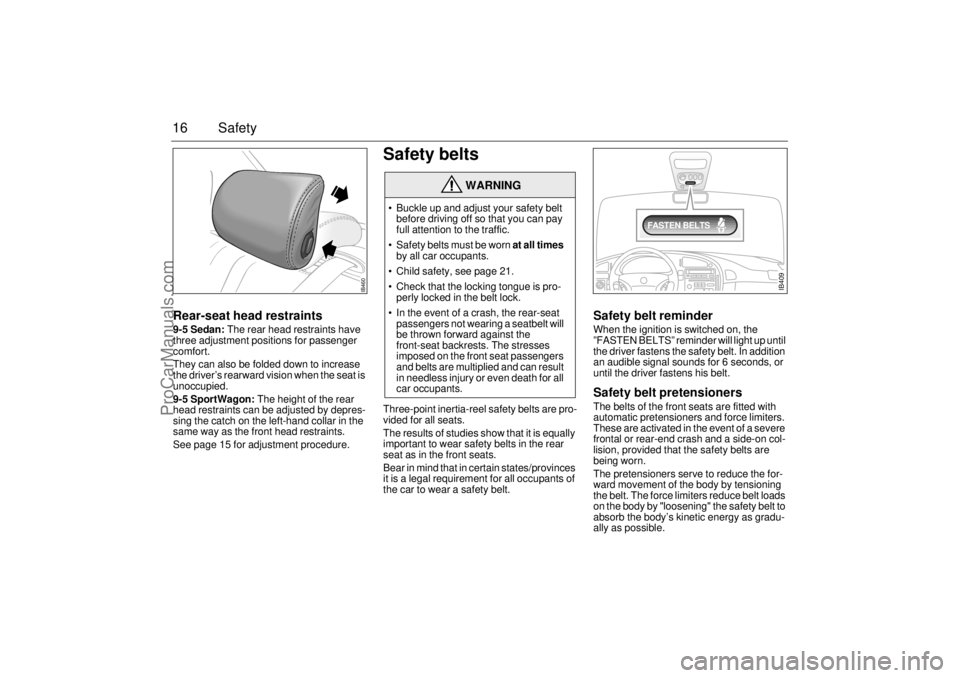
16 SafetyRear-seat head restraints9-5 Sedan: The rear head restraints have
three adjustment positions for passenger
comfort.
They can also be folded down to increase
the driver’s rearward vision when the seat is
unoccupied.
9-5 SportWagon: The height of the rear
head restraints can be adjusted by depres-
sing the catch on the left-hand collar in the
same way as the front head restraints.
See page 15 for adjustment procedure.
Safety belts Three-point inertia-reel safety belts are pro-
vided for all seats.
The results of studies show that it is equally
important to wear safety belts in the rear
seat as in the front seats.
Bear in mind that in certain states/provinces
it is a legal requirement for all occupants of
the car to wear a safety belt.
Safety belt reminderWhen the ignition is switched on, the
”FASTEN BELTS” reminder will light up until
the driver fastens the safety belt. In addition
an audible signal sounds for 6 seconds, or
until the driver fastens his belt. Safety belt pretensionersThe belts of the front seats are fitted with
automatic pretensioners and force limiters.
These are activated in the event of a severe
frontal or rear-end crash and a side-on col-
lision, provided that the safety belts are
being worn.
The pretensioners serve to reduce the for-
ward movement of the body by tensioning
the belt. The force limiters reduce belt loads
on the body by "loosening" the safety belt to
absorb the body’s kinetic energy as gradu-
ally as possible.
WARNING
Buckle up and adjust your safety belt
before driving off so that you can pay
full attention to the traffic.
Safety belts must be worn at all times
by all car occupants.
Child safety, see page 21.
Check that the locking tongue is pro-
perly locked in the belt lock.
In the event of a crash, the rear-seat
passengers not wearing a seatbelt will
be thrown forward against the
front-seat backrests. The stresses
imposed on the front seat passengers
and belts are multiplied and can result
in needless injury or even death for all
car occupants.
IB460
IB409
FASTEN BELTS
ProCarManuals.com
Page 19 of 276
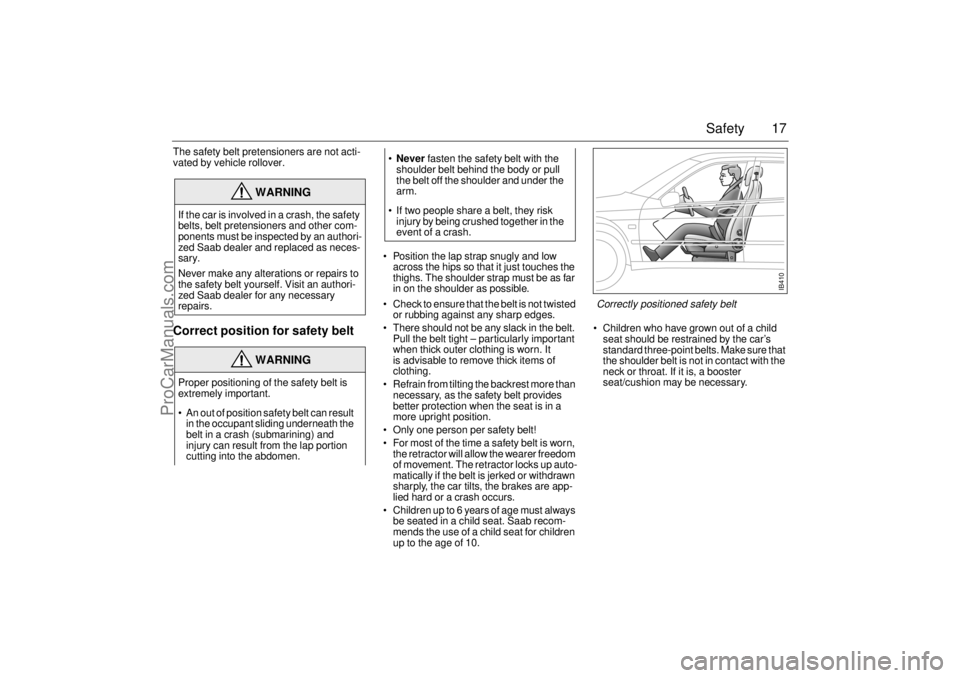
17 Safety
The safety belt pretensioners are not acti-
vated by vehicle rollover. Correct position for safety belt
Position the lap strap snugly and low
across the hips so that it just touches the
thighs. The shoulder strap must be as far
in on the shoulder as possible.
Check to ensure that the belt is not twisted
or rubbing against any sharp edges.
There should not be any slack in the belt.
Pull the belt tight – particularly important
when thick outer clothing is worn. It
is advisable to remove thick items of
clothing.
Refrain from tilting the backrest more than
necessary, as the safety belt provides
better protection when the seat is in a
more upright position.
Only one person per safety belt!
For most of the time a safety belt is worn,
the retractor will allow the wearer freedom
of movement. The retractor locks up auto-
matically if the belt is jerked or withdrawn
sharply, the car tilts, the brakes are app-
lied hard or a crash occurs.
Children up to 6 years of age must always
be seated in a child seat. Saab recom-
mends the use of a child seat for children
up to the age of 10. Children who have grown out of a child
seat should be restrained by the car’s
standard three-point belts. Make sure that
the shoulder belt is not in contact with the
neck or throat. If it is, a booster
seat/cushion may be necessary.
WARNING
If the car is involved in a crash, the safety
belts, belt pretensioners and other com-
ponents must be inspected by an authori-
zed Saab dealer and replaced as neces-
sary.
Never make any alterations or repairs to
the safety belt yourself. Visit an authori-
zed Saab dealer for any necessary
repairs.
WARNING
Proper positioning of the safety belt is
extremely important.
An out of position safety belt can result
in the occupant sliding underneath the
belt in a crash (submarining) and
injury can result from the lap portion
cutting into the abdomen.
Never fasten the safety belt with the
shoulder belt behind the body or pull
the belt off the shoulder and under the
arm.
If two people share a belt, they risk
injury by being crushed together in the
event of a crash.
IB410
Correctly positioned safety belt
ProCarManuals.com
Page 20 of 276

18 SafetyFront safety belts Fasten the belt by pulling the belt and inser-
ting the tongue in the buckle. Check that it is
securely fastened.
Grasp the shoulder belt close to the buckle
and pull the belt towards the shoulder to
tighten the lap belt part.
Then grip the belt at the shoulder, pull it out
and, without letting go, allow the slack to be
taken up by the reel. Make sure that the belt
is well in on the shoulder.
Because the lower belt-anchorage points
are on the seat, the belt buckle follows the
movement of the seat during seat adjust-
ment.To release the belt, press the red button on
the belt buckle, as illustrated.
See page 235 for the checking of belt func-
tion, cleaning, etc.
Belt height adjustmentThe front safety belts and the outside belts
in the rear (9-5 Sedan) are equipped with
automatic height adjustment.
After fastening the belt, grasp it at chest
height, pull it out and, without letting go,
allow the slack to be taken up by the reel.
Make sure that the belt is well in on the
shoulder.
IB411
To fasten the belt
IB412
Press the red button to release the belt
ProCarManuals.com